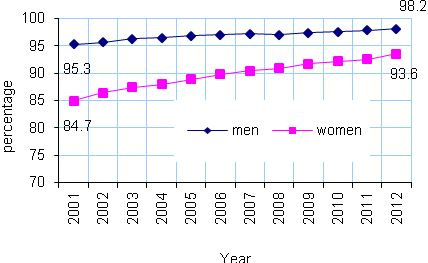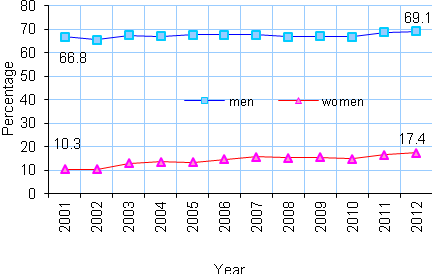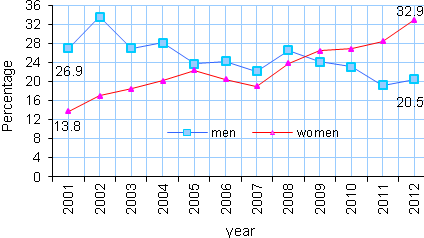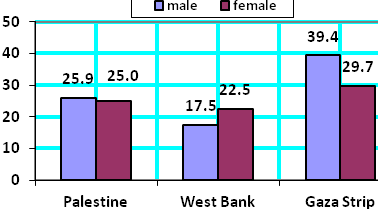Palestinian Central Bureau of Statistics (PCBS)
International Women’s Day 2013
Females make up 49.2 percent of Palestinian society
The estimated population of Palestine at the end of 2012 was 4.35 million of whom 2.21 million were males and 2.14 million females. Males comprise 50.8 percent of the total population compared to 49.2 percent for females. In other words, for every 100 persons there were 49 females, a sex ratio of 103.2.
More than half of females aged 15 years and above are married
Six out of every 10 females aged 15 years and above were married while three women out of 10 were never married. In addition, 5.8 percent were widowed, 1.5 percent divorced, 2.2 percent engaged for the first time, and 0.2 percent were separated.
Decline in illiteracy among women
Illiteracy among females was three and a half times higher than among males: illiteracy among males was 1.8 percent compared to 6.4 percent among females in 2012. illiteracy rates for females were 15.3 percent in 2001.
The percentage of women with a (associated) diploma and above was 16.4 percent in 2012.
Literacy rates for men and women aged 15 years and above during 2001-2012

Limited female participation in labor force
Despite the rise in female employment in the labor force over the past ten years, the female participation rate remained low at 17.4 percent of females in the labor force in 2012 compared to 10.3 percent in 2001.
The male labor force participation rate was still around four times higher than that of females.
There was a gap in the average daily wages of men and women: the average daily wage for women represented 86.8 percent of that of men's in 2012.
Males and females labor force participation aged 15 years and above during
2001-2012

Higher unemployment among women
Females participation in the labor force was considered important for sustainable development, yet the female unemployment rate increased to 32.9 percent in 2012 compared to 13.8 percent in 2001. The unemployment rate was the highest among women with 13 years of schooling at 44.6 percent in 2012.
Unemployment rate among men and women 15 years and above 2001-2012.

Agricultural sector
In 2009-2010, 7.9 percent of plant agricultural holdings were held by women compared to 92.1 percent were held by males. In addition, 7.6 percent of animal agricultural holdings were held by women against 92.4 percent were held by males.
Women and poverty
The proportion of poor families headed by a female is higher in the Gaza Strip at 29.7 percent compared to 22.5 percent in the West Bank.
Percentage of deep poverty by sex of household heads in 2010

Males witnessed corruption more than females
39.4 percent of governmental females workers in the West Bank were subjected to or witnessed an act of corruption (wasta, bribe and others) during 2008-2009 compared to 54.1 percent of males over the same period.
Violence against women
According to women's centre for legal aid counseling, 13 women were killed in Palestine in 2012 for different reasons.
Health sector
Out of registered physicians, 14.3 percent were females and 85.7 percent males. The percentage of females registered physicians was higher in the West Bank (17.8 percent) than in Gaza Strip (10.9 percent).
More than one quarter of registered dentists were females and 72.8 percent were males in 2011. The percentage of females registered dentists was higher in the West Bank (28.0 percent) than in Gaza Strip (25.0 percent).
Just over half (52.0 percent) of registered nurses were females and 48.0 percent males in 2011. The percentage of female nurses was higher in the West Bank (62.0 percent) than in Gaza Strip (44.2 percent).
Women in public life
Out of local council members, 20.7 percent were females compared to 79.3 percent male in the West Bank. In 2012, the highest participation rate for women in local councils was in Ramallah and Al-Bireh governorate with 18.9 percent while the lowest was in Jericho and Al-Aghwar governorate with 2.3 percent in 2012.
Also, 4.3 percent of ambassadors were females compared to 95.7 of males and 17.1 percent of journalists were females compared to 82.9 percent of males in 2011.
In the public sector, 40.6 percent of employees were females in 2012 compared to 59.4 percent of males.
 عربي
عربي